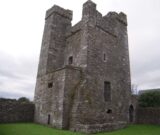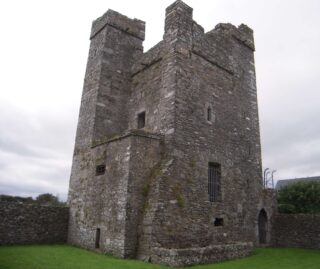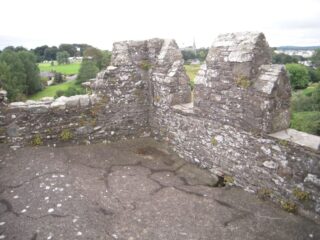Notice
Termonfeckin Tower House is a National Monument in state guardianship
*Keys to access the interior of the existing building are available from a neighbouring house for a €50 deposit, the details of which are to be found on the tower house’s boundary gate*
WARNING: It should be noted that these sites are unguided and a level of care and caution should be maintained during all stages of your visit. The Office Of Public Works (OPW) will not be held responsible for any damages, injuries, or losses that occur
Termonfeckin Tower House
Termonfeckin village, also known in the past as Torfeckan, was, at a very early time in its history, an important monastic site. It is recorded as having been founded by St. Fechin, of Fore in Co. Westmeath, in 665AD. Remnants of its important ecclesiastical past can be seen in the sites of two early churches, its intact high cross, the base of a second cross, and an inscribed cross-slab. An abbey for Augustine Regular Canonesses, under the invocation of the Blessed Virgin Mary, was confirmed here by Pope Celestine III in 1195AD.
As one of its two significant fortified buildings, Termonfeckin Tower House is perched on one of the highest points in the village, on the edge of ground that falls sharply away towards the nearby eastern shoreline of the Irish Sea. The tower house is three stories tall, with a parapet on top, as well as a look-out tower and a platform on its coastal side.
Some records suggest that it was erected following the Norman conquest of Ireland, while others say that it dates from the early 16th century reign (1509-1547) of Henry VIII of England, though it might be from earlier than that latter period, and be one of the £10 castles and tower houses, dating from between 1429 and 1439 in the reign of Henry VI, which were ordered by the King to be 20 feet in length, 16 feet in width and 40 feet in height.
The tower house was damaged during the Confederate Wars in 1641, after which time Captain James Brabazon repaired and made some alterations to it. In an issue of the Dublin Penny Journal in 1834 it was stated that it was, at that time, inhabited by mendicants and was known as the "Curate’s House". In the 1860s the tower house was the property of the Reverend William Brabazon (1798-1882), of Rath House, Termonfeckin, who, along with many members of his locally landowning ancestors, is buried in the family vault in the nearby Church of Ireland churchyard.
The building is constructed of roughly-coursed limestone blocks, boulders and greywacke, a hard, dark sandstone. The tower is entered through a doorway of hammer-dressed limestone, which replaced an earlier entrance, the filled-in remains of which can still be seen to the left of the current opening. This doorway leads into a very small unroofed passage, which, to its left side, opens firstly onto a stairwell for the spiral staircase that ascends to the roof, and beside it, secondly, into a barrel-vaulted ground-floor room.
On the first floor there is a fireplace and a garderobe, or toilet, as well as a recessed seating area, while on the second floor there is another garderobe and in the walls of the main room there are small single-light trefoil windows of finely-carved granite.
The most interesting feature of the tower house is the beautifully corbelled roof of the third storey, unique in buildings constructed in this era, and reminiscent of the corbelled burial chamber in the prehistoric passage tomb at Newgrange in neighbouring Co. Meath.
From its fine stepped and crenelated battlements there are commanding views over the sea to the east, as well as over the surrounding countryside towards the north and south, and over the village itself to the west.
This building should not be confused with the now-demolished Termonfeckin Castle, which once stood on a sloping ridge beside the Ballywater River in the middle of the village. The castle had been the retreat, for three months of the year, for the Archbishops of Armagh. Prior to its burning in 1641 by the Puritan soldiers of Oliver Cromwell’s army, James Ussher (1581-1656), Archbishop of Armagh and Primate of All Ireland, was its last inhabitant.
Its ruins were illustrated as early as 1748 in Thomas Wright’s 'Louthiana', as well as in 'The Antiquities of Ireland’ by Francis Gross in 1793, and as late as 1830, under the name of Torleckan Castle, in James Harding’s 'Picturesque Views of the Antiquities of Ireland, Volume 2', which was published in that year. By the time of the Ordnance Survey mapping of the village in the early 1830s, all traces of this castle, and the round crenelated turret that stood beside it, had completely disappeared.
Visit Historic Environment Viewer for more information on Termonfeckin Tower House
Protect our Past - Click here to read about the importance of protecting our country’s unique heritage sites
This national monument is protected in accordance with the National Monuments Acts 1930 to 2014
Gallery
Nearby sites to visit
Battle of the Boyne Visitor Centre – Oldbridge Estate
Where two kings fought for Europe’s future
Approx. 10.9 km from Termonfeckin Tower House
Old Mellifont Cistercian Abbey Monastic Site
Visit Ireland’s very first Cistercian foundation
Approx. 13.1 km from Termonfeckin Tower House
Brú na Bóinne Visitor Centre: Newgrange, Knowth and Dowth
Step into Ireland’s richest archaeological landscape
Approx. 14.3 km from Termonfeckin Tower House



